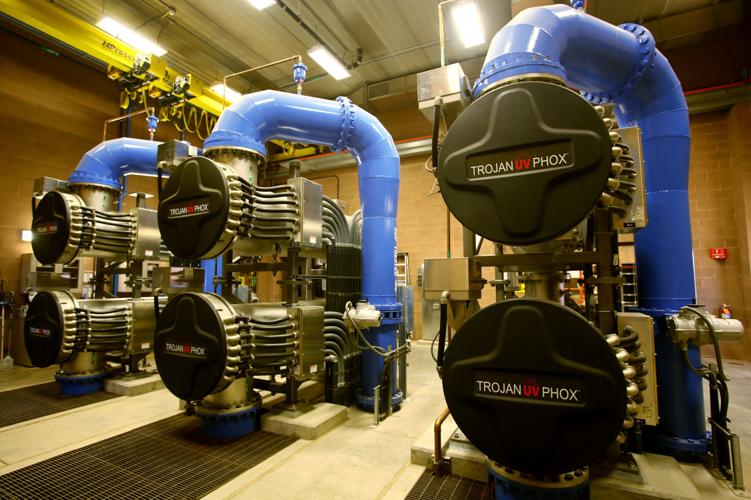By far the highest levels of the PFAS family of toxic compounds ever found in the Tucson area have turned up in a swath of the south side’s aquifer, directly north of an Air National Guard base adjoining Tucson International Airport.
While city drinking supplies aren’t contaminated there, three private wells in the same area have turned up with PFAS concentrations exceeding what the EPA says should be served to people, Tucson Water officials say.
The PFAS levels, discovered in a series of city monitoring well tests, peaked at 13,850 parts per trillion. That’s nearly 200 times the Environmental Protection Agency’s health advisory recommendation for drinking water of 70 parts per trillion.
The federal government says that when consumed at high enough levels over a lifetime, the PFAS compounds could cause a long list of ailments, led by kidney and testicular cancer, along with developmental delays in fetuses and children, decreased fertility, changes to the immune system and increased asthma risks.
In all, five monitoring wells containing PFAS concentrations ranging from 1,030 to 13,850 parts per trillion were discovered in Tucson Water samples taken in early June. A second round of samples from late September confirmed the earlier findings, saying those five wells plus a sixth tainted at 2,250 to 12,370 parts per trillion, a city-financed report from a private consultant shows.
In separate testing done by the state, one of the three private wells had PFAS levels of 2,300 parts per trillion, Tucson Water Director Tim Thomure wrote in an email last week to the City Council. Another well came in at just above 70 parts per trillion, while the third well’s level wasn’t stated in the email. The Arizona Department of Environmental Quality is providing bottled water to those residents with contaminated private wells who lack an alternative source, such as city water, Thomure wrote.
So far, ADEQ has tested eight wells in that south-side area and eventually will test 90 such wells, Thomure wrote. ADEQ hasn’t responded to questions from the Arizona Daily Star seeking more information about the test results and the residents whose wells are contaminated.
The highest concentrations discovered through the city testing are among the worst examples of PFAS pollution found nationally in areas associated with a military base but lying outside the base, national researchers and environmental groups told the Star.
The Air Force has said it suspects the military spilled or discharged PFAS compounds, also known as perfluorinated compounds, at 401 military bases around the country where the chemicals have been used in firefighting foam.
The section of the south-side Tucson aquifer suffering from the latest contamination hasn’t supplied city drinking water for several decades, since the early discoveries of another groundwater contaminant, trichloroethylene, in the early 1980s, utility officials say.
But the newly found contamination could ultimately threaten public water supplies later, officials say. That’s because it appears to be heading toward a series of south-side wells from which the city is now pumping less-contaminated water for eventual cleanup by its multimillion-dollar treatment plant that’s been in use for 25 years.
The concern is that the newly discovered contamination could ultimately overwhelm the plant, the Tucson Airport Remediation Project (TARP), that treats TCE and 1,4-dioxane as well as PFAS compounds. The plant has gone through upgrades to increase its ability to treat PFAS, but not at anywhere near the concentrations just discovered.
“We don’t anticipate this contamination being in TARP wells at those concentrations for years. I can’t put a number on it, but we have time,” Thomure said. “It’s urgent but not an emergency.
But, “the sooner someone, whoever that is, puts in a remedy in the zone where high concentrations are, the better,” Thomure said in an interview.
City Councilman Steve Kozachik, who provided the Star with the latest PFAS monitoring reports, takes a more aggressive stance toward the contamination.
While the city is already suing manufacturing giant 3M for its role in making the compounds to help pay for cleaning up this water, he wants the city to now separately sue the state and federal governments to pay for cleanup as well. He wants the U.S. Defense Department also sued because high PFAS levels have been found in now-closed city wells lying just north of Davis-Monthan Air Force Base, although the base hasn’t acknowledged responsibility for that contamination.
“I’m tired of this slow walking. The state is responsible for the Air National Guard. They need to be brought into our litigation,” said Kozachik.
He’s particularly concerned because the south- side aquifer someday could be needed as a drinking supply again, should declining Colorado River flows ever trigger cutbacks in Central Arizona Project deliveries to Tucson and Phoenix, he said.
“My perspective is that the time to be fixing it is now and not when it is an imminent problem and we’re handing out bottled water to people,” Kozachik said. “Litigation takes time. Building treatment plants takes time. Determining the limits of the (pollution) plume takes time.”
Extent of the contamination plume not known
The worst aquifer contamination found in the recent tests stretches from near South Campbell Avenue and East Valencia Road to the south, to near South Park Avenue and East Drexel Road to the north.
The southern edge of the newly discovered contamination lies just north of where the 162nd Wing Air National Guard base has operated for many decades at the airport property.
Lesser but still significant contamination levels, up to 2,100 parts per trillion, were discovered in monitoring wells lying near Drexel, almost as far west as South Sixth Avenue, a map accompanying the city’s consulting reports shows.
The area is just a few blocks away from the closest band of wells that are pumped for cleanup at the city treatment plant.
If the high PFAS concentrations aren’t addressed where they exist today, it’s “a matter of time before we would have to deal with them at the TARP,” Thomure said.
Also, the significant amount of pumping that the city is doing now to extract that TARP water from the aquifer could draw the new contamination closer to the treatment plant, he said.
The Air National Guard facility is suspected by city officials to be a source and possibly a prime source of this contamination. Its own report, released in March, found high PFAS concentrations, some extremely high, in groundwater spread across the Air Guard base.
The Guard was using the firefighting foam in fire trucks until December 2016 and in a base hangar until July 2018, its officials have said. The Guard hasn’t disclosed when the base started using the foam, although national reports say the foam usage on military bases dates back to the 1970s.
“I think it’s safe to presume the Air National Guard is a contributor, because of their own report,” said Bill Ellett, a retired ADEQ hydrologist who worked closely on the PFAS issue before he left the agency in December 2018.
Once all direct human exposure to the contamination is eliminated, the next step should be for authorities to define the contamination’s extent with a full-fledged remedial investigation and learn what other sources there are, Ellett said in an interview.
“You need to understand the problem thoroughly before you can start thinking about how to clean it up with engineering solutions,” Ellett said.
In its November 2019 report to Tucson Water on the latest PFAS discoveries in the aquifer, consultant Clear Creek Associates echoed those thoughts, saying, “It is recommended that additional wells east of the project area be monitored to delineate the extent of PFAS.”
A plan to expand the city’s PFAS sampling in that area “is under development,” Thomure said.
But since this area isn’t near where the city produces its customers’ drinking water, “it is a lower priority than our other sampling areas,” said Thomure.
“We focus our PFAS sampling to assure that our drinking water is safe. This is a voluntary investigation to characterize this part of the aquifer, well before it can affect the water that we deliver,” he said.
Tucson levels “extremely high”
National PFAS experts — researchers and environmental groups — say the recent discoveries of the contaminant on Tucson’s south side represent a serious problem needing quick attention.
But they — and utility director Thomure — say one big obstacle to getting a cleanup started is that the EPA hasn’t set a formal, legal drinking water standard for PFAS compounds. Without such a standard, it’s much more difficult or impossible to force polluters and utilities to begin expensive groundwater cleanups, they say.
And because Arizona has a law forbidding the state ADEQ from adopting environmental rules tougher than federal standards, this state can’t set its own contaminant limits.
EPA has said it plans to make a “regulatory determination” on how to deal with the standard issue by the end of 2019. It hasn’t responded to questions from the Star as to what such a determination would involve.
The new Tucson numbers are “extremely high,” said Judith Enck, a former EPA regional administrator in New York who oversaw federal activity toward PFAS contamination from a plastics manufacturing plant in Hoosick Falls, New York.
“Even if it is not currently used as a drinking water source, groundwater needs to be protected and in this case remediated,” she said.
She found it “worrisome” that the water was used for drinking in the past, saying it’s possible that the PFAS could have been in drinking water before the city shut its south-side wells down in the early ’80s.
PFAS chemicals migrate extremely quickly and remain in the environment indefinitely, said Cole Alder, a research assistant for a PFAS study based at Northeastern University in Massachusetts.
“At the end of the day, these chemicals affect virtually every system in the human body, and pose a very serious threat to the health of humans and ecosystems,” Alder said.
Yet it’s positive that Tucson is actively testing wells for PFAS and has been monitoring for these pollutants for at least a decade, said David Andrews, a senior scientist for the Environmental Working Group. The group compiles a national database of PFAS-contaminated sites and is pushing hard for tough federal legislation to expedite cleanups.
“We find across the country, many systems are not being tested and there’s no requirement for it. Being cognizant of the contaminant is really step one,” Andrews said.
Ultimately, most important, the cost of cleaning up this contamination shouldn’t be passed onto Tucson Water ratepayers, he added. Often with such contamination the cost of cleanup is passed onto consumers, he said.
“The city should be aggressive in making the polluters pay,” he said. “These city wells are no longer usable.”





